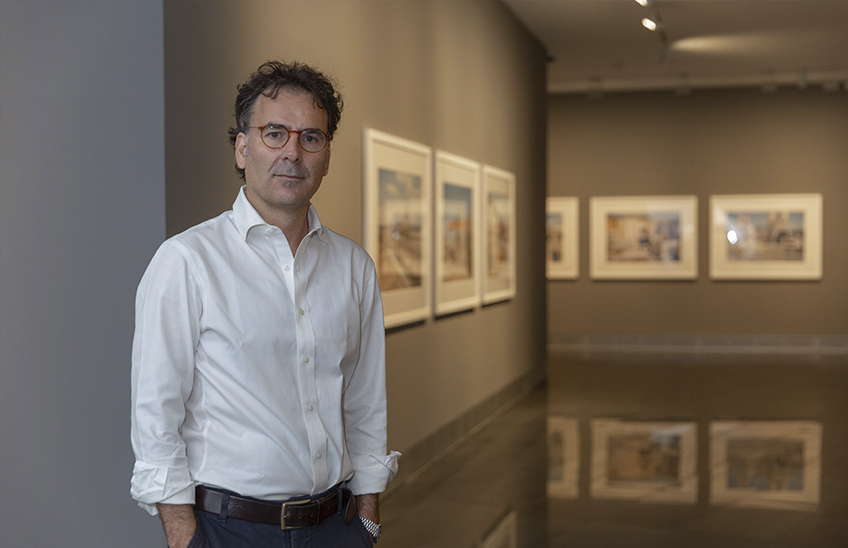Txema Salvans presents at the MUN the exhibition 'The Waiting Game III', a reflection on waiting through the figure of the watchdog.
The photographic exhibition, which can be visited until March 5, is the result of the artist's participation in the Museum's 'Tender Puentes' artistic residency project.

FotoManuelCastells/Artist Txema Salvans next to some pieces from 'The Waiting Game III' at the Museo Universidad de Navarra
03 | 11 | 2022
The van trips along the Mediterranean coast, which Txema Salvans has been making since 2005, from Port Bou to Algeciras, have served the Barcelona artist to portray the wait from a meticulous and patient observation. In The Waiting Game IIIthe photographic exhibition that he has inaugurated at the Museo Universidad de NavarraThe Waiting Game III , he reflects on this concept through the figure of the watchdog. The exhibition, which can be visited at the Torre Hall until March 5, is the result of his participation in the Museum's artist-in-residence program, in which contemporary artists from all over the world are invited to participate. Tender Puentes The exhibition, which can be seen in the Torre Hall until March, is the result of his participation in the Museum's artistic residency program, in which contemporary artists are inspired by the MUN's historical photography collection to create new works.
Traditionally, the dog has been represented fulfilling an instrumental function, as a portrayed subject or as a mere environmental element. In the case of Salvans, the initial driving force has been pieces by José Ortiz Echagüe, Humberto Rivas, Alfonso Sánchez García, Rafael Sanz Lobato and Oriol Maspons, among other authors. But his proposal offers a different perspective. "I approach an image inscribed in the visual memory and, nevertheless, little represented from photography: the dog that guards the property in the absence of its masters, generally chained, who spends his days behind a fence, a wall or a metal fence watching," says the author, who has presented the exhibition accompanied by Valentin Vallhonrat, artistic director of the Museum along with Rafael Levenfeld.
In this series, the figure of the dog is used to address the relationship between human beings and nature, "an example of the submission we impose on our natural environment". The artist is impressed by this dimension of waiting: "There are thousands of dogs tied to a chain or locked up in a small plot of land that spend their whole lives with no other expectation than to keep the property of their masters. It is the most constant and most hopeless waiting, although the domestication of the human being has made some animals submissive to this treatment and they are constantly waiting for the occasion to fulfill the function that has been instilled in them".
But the images not only allow him to talk about the dogs, but also about their owners, even though they do not appear in the images. "My photos speak more about the owners than about the dogs; the architecture of the space and all the elements that surround the dog give us a great deal of information," he says. He does not seek, in any case, to make an explicit denunciation of animal abuse. "Inevitably it is implicit, but what I am trying to do is to review the recurrence of a Mediterranean landscape with an animal figure that, despite technological and urbanistic changes, is transhistorical of the animal function, which remains in force despite sophisticated motion sensors and video surveillance. The dog, so far, has no more productive replacement".
THREE DELIVERIES
With The Waiting Game III, Salvans completes a trilogy that began in 2005. The first, dedicated to portraying prostitution on the road; and the second to a special type of fishermen who go to ditches, marshes or ports in the Mediterranean area, without a real pretense of catching something. "Waiting, the common denominator of the project, is perhaps the most constant temporal component of our lives. Waiting does not leave as strong a mark on our memory as the acts we perform or that come upon us, and yet we are all always waiting for something. All waiting is possible and in all of them there is a suspended time that is full of unknowns," explains the artist.
Other issues that run through all the works are the decisions on the aesthetic level. In this sense, he details the three key premises that respond to his rigorous work protocol for taking the images: "The distance: the photos are taken at a distance from the subject that allows showing the environment and protecting the identity of the character. The distance emphasizes the context, the landscape. The light: the photos are taken in broad daylight, never at dusk or dawn. The harsh light reinforces the desolate character of the images, as well as the rigorous description and the fragility of the subjects. And finally, the moment: the shutter is always released at the moment of waiting, emptying the image of any sexual or emotional display, to end up placing the protagonists in an anti-climax that refers to a slow and sorrowful becoming".
In the development of these works, the artist himself has become a sort of professional of waiting and searching. "I have also waited a lot and, sometimes, like dogs, desperately". Until, in one of those trips, following different information and detours, he finds a prize in the form of a situation to capture with his camera, always in large format and with tripod. "It involves a slow way of working, which further reinforces these conceptual and stylistic traits. The tripod provides a solid anchorage to the place and the moment and provides the indelible mark that each of the decisions taken is consciously assumed," he reveals.